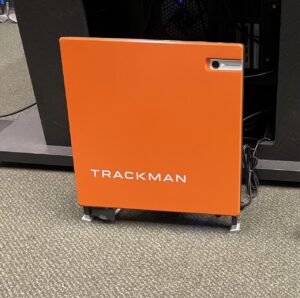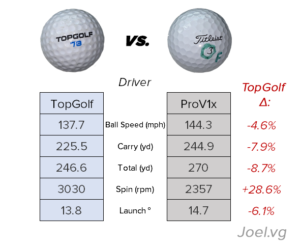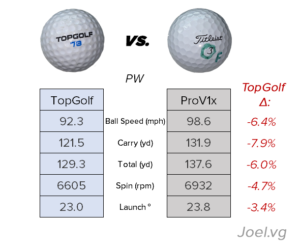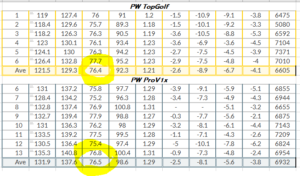Quick summary:
- TopGolf balls do not go as far as typical golf balls
- For me, carry distances were down 8%
- There are multiple reasons why it is advantageous for them to do this
Methods and materials:

Trackman 4 was used, indoors, with about 12 feet of unobstructed flight. All data were normalized to sea level and 75 °F.
A single TopGolf ball was used, which certainly limits the validity here. For what it’s worth I did not steal it, for some reason my driving range has a few random TopGolf balls that occasionally find their way into our buckets. So I guess I did steal it, just not from TopGolf. Regardless, I plan to throw it back on the range next time I hit a bucket to alleviate this crushing weight on my conscience.
A RCT ProV1x was used (what is RCT?), as this was Trackman and it’s difficult to get spin readings without a RCT ball.
To ensure the ‘input’ was close enough to make a fair comparison, I ensured clubhead speeds were equivalent in both groups. I excluded several early PW shots as there was a warm-up bias where I was swinging a few mph slower at the beginning of the session. After the exclusions, the clubhead speeds were nearly identical at 76.4mph and 76.5mph in the two groups. Club path, face to path, and angle of attack were consistent within the groups as well, as AoA especially would influence backspin. I excluded one data point from the driver ProV1x data, where I swung a few mph faster.
Limitations
There was only about 12 feet of unobstructed ball flight for Trackman to read. Of note, Trackman gave me several italicized spin numbers with TopGolf balls (italics means spin was not actually measured but only estimated based on impact conditions – i.e., italics = less accurate – more info here) I did not get any italicized parameters with the RCT ProV1x.
This means the spin accuracy is questionable. Indoors, this is difficult to avoid. As discussed above, I only had one TopGolf ball to use.
Discussion
Results can be seen in the images at the top of this page.
This provides context to the observation that many of us have made when we go to TopGolf, which is that it feels like the ball doesn’t go anywhere.
Results reflect what I have seen in many range balls, which is more spin off of woods, less spin off of irons or wedges. Had I hit my 56°, I suspect spin would have dropped from 10,000 to something like 8,000 rpm. A slight penalty on ball speeds as well. Anecdotally, I have seen about a 5% ball speed dropoff from range balls to TopGolf balls, however I’ve never had the chance to compare a premium ball to TopGolf.
I find this information useful because it plays into the argument of whether one can drive a ball over TopGolf’s back net. I hope to follow up with another post on that, but the limited flight of TopGolf balls becomes quite relevant here.
Why is this the case?
Golf balls meant for course play and golf balls meant for repeated usage on a driving range have fundamental differences in design. Balls meant for play on a course (we’ll call them “premium balls”) are optimized for launch and spin to provide the best performance. The urethane covers on these premium balls, while providing the best trajectory and spin profile, are soft and cannot stand repeated impacts. Balls for driving ranges (and TopGolf) are built less for performance but instead for survival – they have essentially the hardest, most durable covers feasible, to ensure their survival over thousands of impacts. For some driving ranges, balls are replaced annually or even less often.
In addition, premium golf balls’ cores are once again designed to optimize launch and speed. TopGolf balls require the inclusion of an RFID chip in their plastic core (see image below!). This foreign, non-homogenous core almost certainly is less efficient than a normal core, and ball speeds will take a hit compared to balls that do not necessitate the inclusion of chips.
Finally, it suits TopGolf from a business perspective to have limited flight golf balls. Even without RFID chips, some driving ranges choose to use limited flight golf balls, which are designed to be slower, to save space. Driving ranges with real estate limitations use these often. A TopGolf range is expensive to construct, and needing 250 yards of range and fencing saves costs over a 350 yard range, which might be typical for a normal driving range.




Went to Top Golf for the first time today and thought I had lost 40 yards off my driver. This is a relief that the limited flight balls provide some measure of relief to my psychological well being.